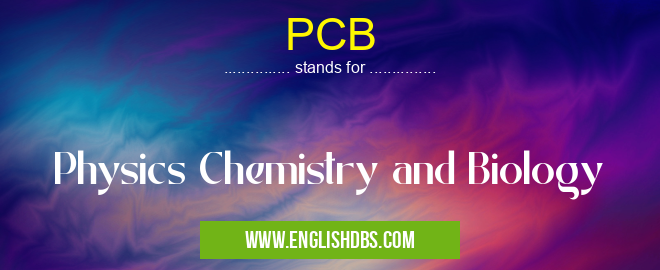What does PCB mean in BIOLOGY
PCB stands for Physics, Chemistry, and Biology. It is a term used in the context of science education to refer to the three core scientific disciplines that are essential for a comprehensive understanding of the natural world.

PCB meaning in Biology in Academic & Science
PCB mostly used in an acronym Biology in Category Academic & Science that means Physics Chemistry and Biology
Shorthand: PCB,
Full Form: Physics Chemistry and Biology
For more information of "Physics Chemistry and Biology", see the section below.
PCB Meaning in Science
PCB in science encompasses a broad range of topics and concepts:
- Physics: The study of matter, energy, and their interactions.
- Chemistry: The study of the composition, structure, properties, and interactions of matter.
- Biology: The study of living organisms, their structure, function, growth, evolution, and interactions with each other and their environment.
PCB Full Form
Physics Chemistry Biology
What Does PCB Stand For?
PCB stands for the three pillars of science that provide the foundation for understanding the fundamental principles and applications of science in various fields, such as medicine, engineering, technology, and environmental studies.
Essential Questions and Answers on Physics Chemistry and Biology in "SCIENCE»BIOLOGY"
What is PCB?
PCB stands for Physics, Chemistry, and Biology. It refers to the three fundamental branches of natural science that study the physical, chemical, and biological aspects of the universe, respectively.
What is the importance of PCB?
PCB is essential for understanding the natural world and its processes. Physics provides the foundation for understanding the laws of motion, energy, and matter. Chemistry explains the composition and interactions of substances, while Biology explores the structure, function, and behavior of living organisms. Together, PCB provides a comprehensive framework for scientific inquiry and technological advancements.
What are the key concepts in PCB?
PCB incorporates a vast array of concepts, including:
- Physics: Energy, force, motion, relativity, quantum mechanics
- Chemistry: Atoms, molecules, chemical reactions, thermodynamics, organic chemistry
- Biology: Evolution, genetics, cell biology, ecology, human anatomy
These concepts provide the building blocks for understanding the universe around us.
How is PCB applied in real-world scenarios?
PCB finds applications in numerous fields, such as:
- Medicine: Developing new drugs, understanding diseases, and advancing medical technologies
- Engineering: Designing materials, structures, and systems
- Agriculture: Improving crop yields, optimizing soil health, and developing sustainable farming practices
- Environmental science: Monitoring and mitigating pollution, understanding climate change, and preserving biodiversity
PCB is essential for solving complex problems and making informed decisions in diverse areas.
What are the career prospects in PCB?
Graduates with a background in PCB have a wide range of career opportunities in research, academia, industry, and government. Some popular career paths include:
- Scientists: Conducting research in universities, research institutions, or corporate labs
- Engineers: Designing and developing products, systems, and technologies
- Doctors: Applying scientific knowledge to diagnose and treat diseases
- Environmental consultants: Assessing and mitigating environmental impacts
- Science educators: Teaching PCB concepts at all levels of education
PCB provides a strong foundation for a fulfilling and rewarding career in science-related fields.
Final Words: PCB represents the interconnected nature of scientific disciplines, emphasizing the importance of a holistic approach to scientific inquiry. By studying PCB, students gain a comprehensive understanding of the natural world and develop essential critical thinking, problem-solving, and analytical skills.
PCB also stands for: |
|
| All stands for PCB |
